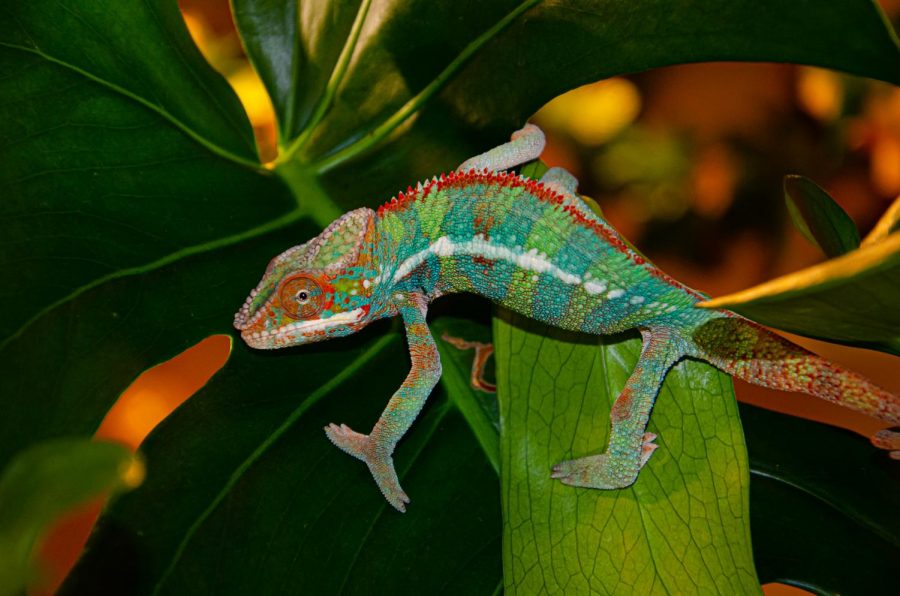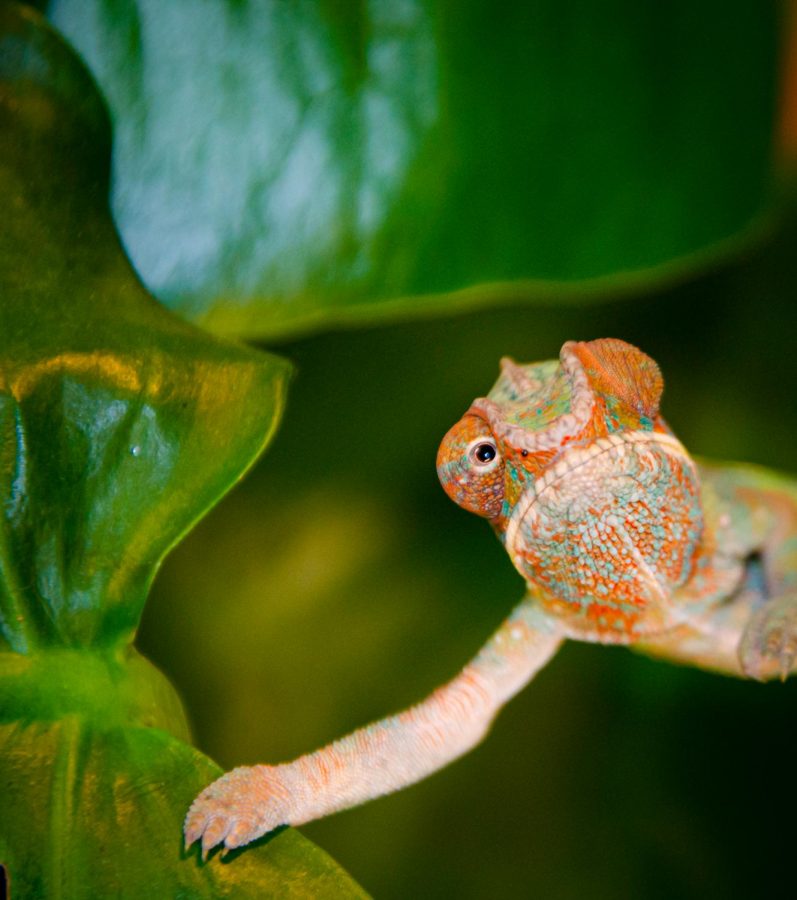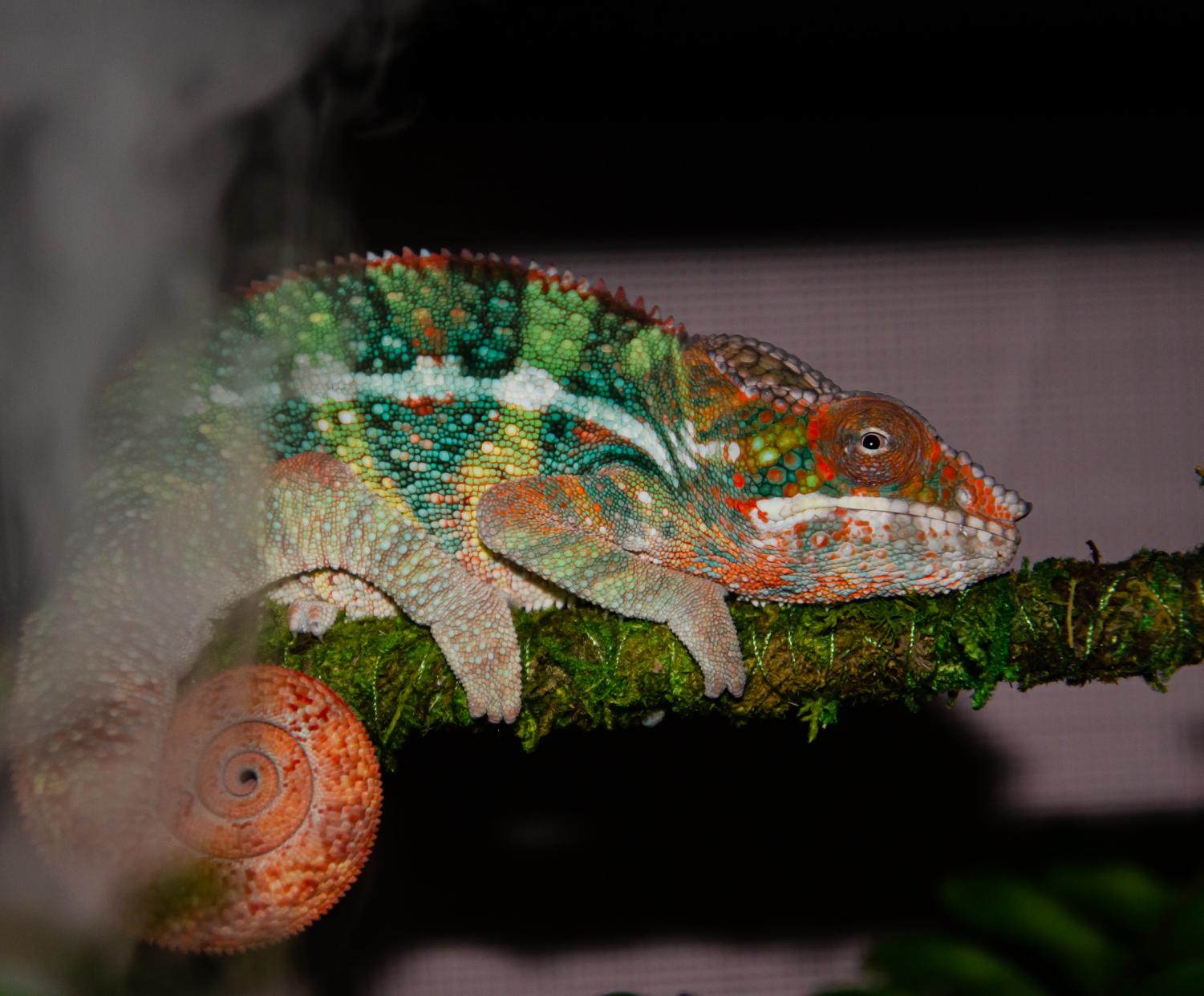Adapting to the unknown: A new life with my ambilobe panther chameleon
Monstera perching
February 3, 2021
I impulsively bought a chameleon…whoops. Armed with an attitude to rival mine and rude until he’s had breakfast, Vinnie is the greatest thing to come from the dumpster fire that was 2020.
I didn’t think it through, that much is obvious. However, when he arrived all tiny, green and feisty, I had no regrets.
Vinnie is spectacular, but he’s also a bit of an asshole. Chameleons are incredibly complicated and delicate creatures, and some come with a bit of a chip on their colorful little shoulders. If you’re not prepared to spend a large majority of time and money ensuring the health and happiness of your chameleon, don’t get one.
While there is usually a learning curve adjusting to the care a new pet requires, Vinnie’s care curve has been a naked hike up Mt. Everest, in a damn blizzard. He’s grumpy and cold, I’m lost and unprepared, and white calcium-dusted bugs have disappeared in the vast wilderness of my room that I know he didn’t eat.
It’s gross.
Nevertheless, if you’re not dissuaded, which is not my intention entirely, here are three things you must know before you bring home your chameleon.
1. Chameleons are very expensive and very fragile
Vinnie has two lights, one for heat and the other is a T5 HO linear UV-B light. DO NOT USE LED OR COIL BULBS, these will cause eye abnormalities. Different subspecies have different heating requirements, so it’s important to do all the research on the subspecies you want before buying. Inconsistent temperatures can cause health issues, a shortened lifespan and death.
Pet stores LIE. If you are going to get a chameleon, please buy one from a reputable breeder. Most will not insist or even be aware that their customers need to buy hundreds of dollars worth of correct equipment. And yes, it’s hundreds of dollars. I’m not kidding. These are not animals you can stick in a tank and call it good.
UV-B light is incredibly important, it imitates sunlight which is essential in helping chameleons produce vitamin D and absorb the calcium in their diet. Without it, they will develop Metabolic Bone Disease (MBD) which causes their bones to slowly bend and break, among other abnormalities. This can also be caused by a lack of calcium in their diet.
Frankly, if you allow this to happen, you shouldn’t be allowed to own any animals. If you see pet stores advertising chameleons without a UV-B light, please yell at them for me. Having now owned a chameleon, I know it’s one of the top killers.
2. They require a specialized diet
Vinnie eats better than me. Honestly, he probably eats better than most people. A variety of feeders consisting of crickets, superworms, waxworms, hornworms, silkworms and dubia roaches adorn the shelves in my room.
Gourmet, I know.
While buying a variety of bugs isn’t complicated, knowing what kinds to buy and their supplement schedule is a little more so. Vinnie’s food is dusted daily 6x a week with calcium without D3. It alternates Sundays–calcium with D3 or a multivitamin. It’s essential you keep it on a rigid schedule so I recommend writing it down on a calendar near their enclosure, as well as checking with a breeder about healthy feeders.
The routine gets easier, although I still feel somewhat like a drug dealer when his adorably spiny face is covered in white powder.
I’m not a girly-girl by any means, I’ll hold the worms so he’ll eat out of my hand (we’re bonding guys), but I refuse to touch the roaches. Therefore, the oversized feeding tweezers bigger than my face will suffice. I recommend them but if you’re convinced you don’t need them, well…godspeed.
Also, don’t forget to gut load your bugs. Yes, you read that right. Gut load. Your. Bugs. Dark greens and carrots are good, your chameleon needs their vitamin A.
3. Proper husbandry is a must
This is something you must take seriously. Their enclosure should be large and vented to prevent respiratory infections which chameleons are very prone to developing. This makes maintaining a consistent high humidity and three-level temperature gradient difficult, but it’s doable.
Live plants make this easier, but please consult a breeder about safe plants. Some chameleons are weird and eat the vegetation, so just because Pinterest said fake ivy is chic, please refrain. I don’t know how to perform CPR on a lizard.
Since chameleons originate from the sunny and tropical island of Madagascar located in the Indian ocean, Oregon leaves something to be desired in the humidity department. Therefore, I just bought a $160 mister and humidifier, no joke.
Chameleons are arboreal and usually will not drink from standing water, so to ensure your chameleon remains hydrated, some source of dripping water is also recommended. There is currently a dripping rainforest in the corner of my room, but I can’t complain.
At least he’s hydrated.
All that being said, if you have the resources and the time to give to a chameleon, absolutely go for it. Vinnie is incredible and even his attitude is endearing. Bonding with your chameleon isn’t the easiest, they’re shy creatures so being patient and waiting for them to come to you is perhaps the hardest thing you’ll face in their daily care. Move slowly, be gentle and don’t grab.
You can tell your chameleons’ mood by the colors they’re showing off. A common myth is that chameleons change color in order to camouflage, but this couldn’t be further from the truth. Colors reflect moods, if they’re dark, your chameleon is likely cold or pissed. Of course if they’re pissed, they’ll puff up their chin and hiss at you. It’s scary..but also adorable.
Pay attention, these lizards are a tad dramatic and will die often seemingly without reason. Having an exotic animal vet on speed dial isn’t the worst idea.
Also, don’t put them near a mirror, they’re self-conscious and stress like the rest of us. No I’m serious, it stresses them out.
Built through patience and a lot of frustration on my end, Vinnie now knows and prefers my handling over anyone else in my household. Although he’s only five months into a hopefully very long seven year lifespan, his trust in me grows everyday.
In fact, he’s been enjoying sitting on my shoulder as I finish writing this, casting one critical eye and an occasional sharp set of claws over my work. The other eye is focused on the bug shelf, the beefy little glutton.
I assure you, they are well worth the wait.




Tyler • Jan 25, 2022 at 7:49 am
This is great! Vinnie looks very healthy! I went down a similar path in 2021. I wanted a chameleon for many years but I am very glad I waited until now to get one since I am older and much more patient. I read for weeks on the forums, etc. about what I needed and I had an enclosure running for a few weeks before I finally ordered a Nosy Be male from a breeder. Even after all of my preparation I still had to adapt some things to his preferences but he’s now a beautiful eight month old little tree dinosaur. After feeding him from my hand for awhile he eventually started climbing out onto my arm and now he likes to do laps up one arm and down the other. I’ve enjoyed my time with him so much I actually got him a ten month old female companion (in a separate enclosure of course) to eventually try breeding on my own. It’s fascinating to see the difference in personality between the two. Anyway, Vinnie looks amazing and it’s great to see caring chameleon owners with proper husbandry after some of the posts I come across online.
Ashley S. • May 16, 2021 at 3:43 pm
Well written!
I have a make and female on the way and I have been in love since day one. I can tell you as of 2021 I spent all over $1200 just bringing everything together for two panther chameleons. I spent about a year researching and waiting for the right time. And even now I learn new stuff everyday.
If you really want one make sure you have gone thru the whole checklist and that includes feeders and possibly care for them as well. Also don’t go to a pretty shop, find a responsible breeder with current good reviews and call them before purchasing online.
Yoshi has been such a treasure having, but he costs about as much as a dog, maybe more. It’s a emotional and financial commitment.
Becqui • Apr 2, 2021 at 3:39 pm
I totally understand Charlotte!
We’ve had our Ambilobe Chameleon for 5 weeks now, & we’ve already upgraded his tank to something that would represent a 1st class Hotel in our World!
We’ve chased Locusts around the living room & go to sleep scratching, wondering if we’re carrying runaway, (hop away) insects!
However, he’s the most adorable & fascinating thing that has ever come into my life!
I love him more every day, & wouldn’t dream of changing a thing!